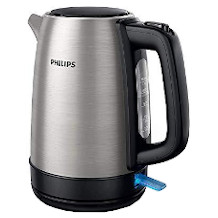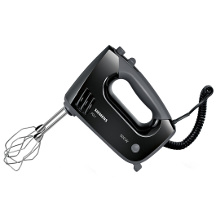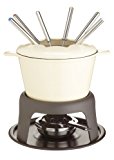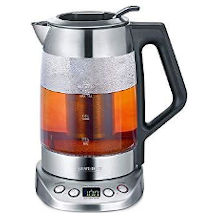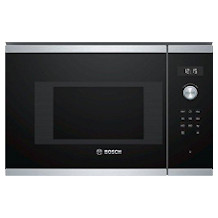Yoghurt maker purchasing advice: how to choose the right product
- What you need to know
- Having your own yoghurt maker allows you to make yoghurt at home, removing the need for you to buy it ready-made at the supermarket.
- It is up to you which ingredients you put in, allowing you to make whatever kind of yoghurt you want.
- There are electric and non-electric yoghurt makers, although electric ones are more common.
- The most important factors to consider before buying a yoghurt maker are: number and size of containers, number of different features, and the amount of yoghurt you can produce.
Homemade just tastes better
Most people buy their favourite yoghurt at the supermarket simply because they believe that there is no alternative. Well, now there is! Those who choose to use a yoghurt maker stand to benefit in two important ways: saving money and having control over your ingredients. It’s common knowledge that buying ready-made products from the supermarket doesn’t come cheap. That said, the main reason to switch to making yoghurt at home is to regain control over the manufacturing process. Not everyone is aware of what goes into a shop-bought yoghurt, either because they don’t understand the terms used in the nutrition label or because they simply don’t have enough time. This problem can be circumvented with a yoghurt maker, helping you create yoghurt exactly to your culinary and dietary preferences.
Yoghurt: what is it & how is it made?
Yoghurt is one of the most popular food products worldwide. One of the reasons for this is its versatility. In the morning, yoghurt gives you energy. At lunch time, it can be easily eaten anywhere on the move. In the evening it is an ideal dessert. Put simply, yoghurt can be enjoyed whenever, wherever. The second thing to know about yoghurt is that it is the perfect accompaniment to a number of different toppings — from fruit and muesli, all the way to chocolate.
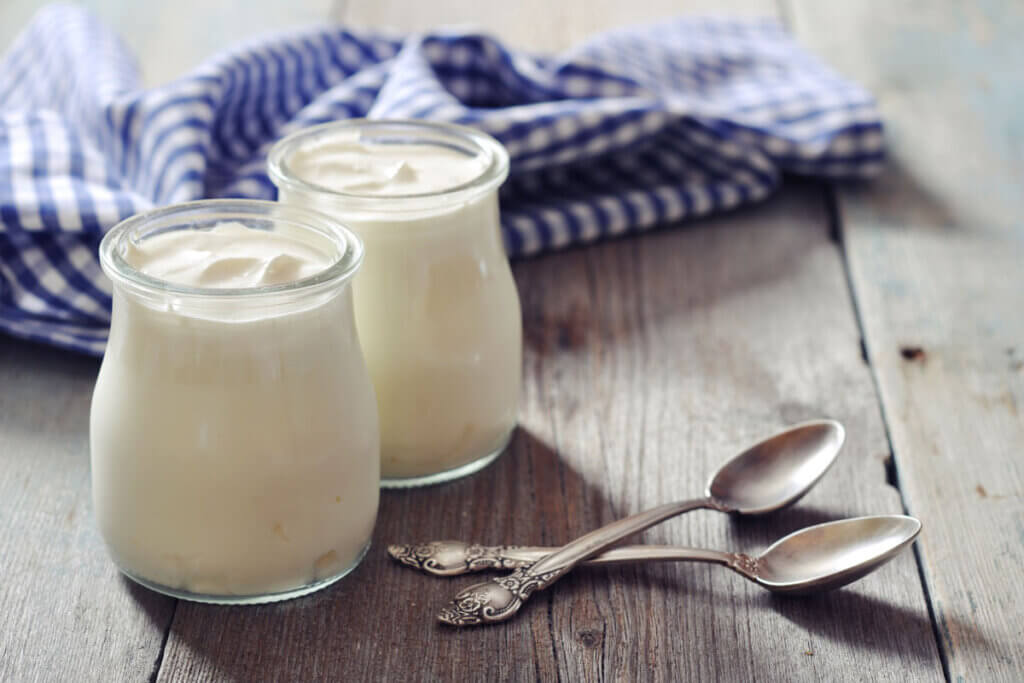
The process by which yoghurt is made is known as fermentation. As part of the fermentation process, certain lactic acid bacteria, or ‘yoghurt cultures’, are employed to change the texture of the milk. What may appear strange at first glance is in fact an age-old technique, in which milk proteins curdle to create natural yoghurt.
What is a yoghurt maker?
Yoghurt makers are an easy way for you to make yoghurt at home. Yoghurt is produced from only a few simple ingredients, making the preparation quick and easy. This doesn’t mean, however, that you cannot be creative with it. With a yoghurt maker, you have complete control over the sweetness of your yoghurt. You can even decide not to use sugar at all! Vegan yoghurts and lactose-free versions are also possible. Making yoghurt at home also reduces plastic waste and offers a cheap alternative to supermarket products. So long as the temperature is maintained correctly, the quality of the yoghurt is extremely consistent.
With these advantages of homemade yoghurt in mind, it should also be noted that yoghurt makers accrue electricity costs, take up space in the kitchen and the resulting yoghurt can only be kept for a short period of time. Furthermore, making yoghurt at home can take several hours.
Advantages
- Control over the ingredients
- Yoghurt can be made to your taste
- Easy to use
- Value for money
- Reduced plastic waste
- Quality as good as with ready-made products
Disadvantages
- Energy intensive
- Requires space in the kitchen
- Quickly goes bad
How does a yoghurt maker work?
While all yoghurt makers serve the same function, making yoghurt, not all models are the same. There are two main types of yoghurt maker, both with their particular strengths and weaknesses.
How is a yoghurt maker made?
Although a lot of yoghurt makers use electricity, this is not always the case. For those looking to avoid having another electricity-guzzling appliance in the kitchen, there are also a select number of models which work simply by using hot water. The second most important thing to be aware of is the number of glass containers. Some models come equipped with several small containers, whilst others simply have one large one. On the one hand, choosing a model with several small containers results in more cleaning. On the other hand, small containers allow you to make yoghurt in portions which can be stored easily in the fridge, removing the need to portion the yoghurt into further containers.
Some electric yoghurt makers are also capable of making other products, like cream cheese, cheese curds, or cheese itself. Electric yoghurt makers are generally easier to use thanks to their automatic temperature control and ability to turn off automatically. Cordless models can be picked up and used almost anywhere. Such models are often good for making large quantities. They also provide warming and cooling options.
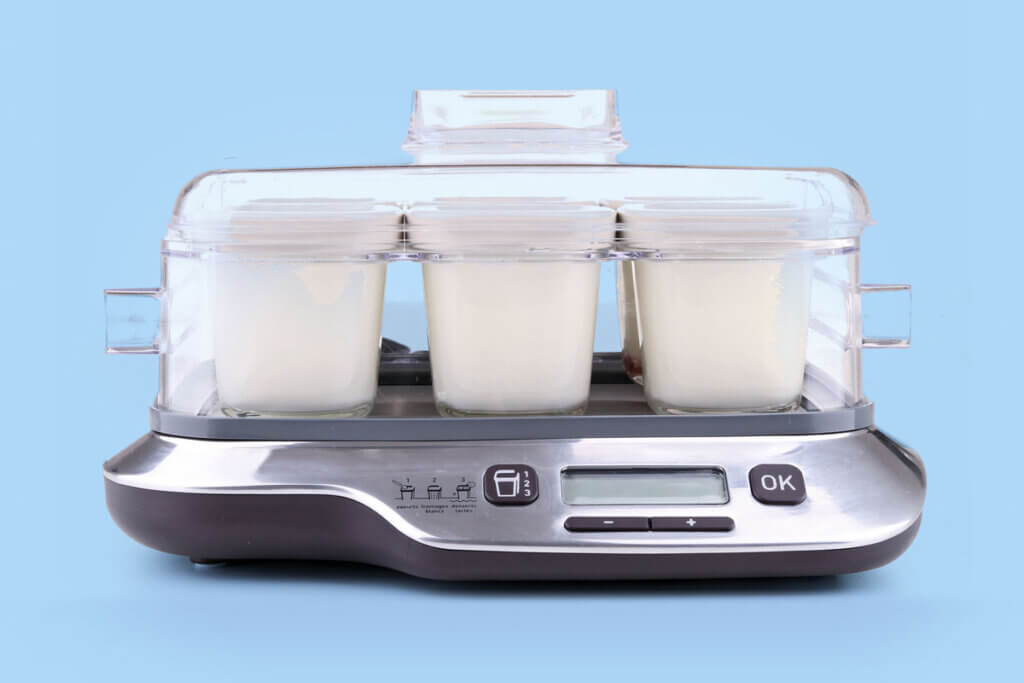
Electric models have the following advantages:
- Easy to use.
- Automatic temperature control
- Can be used to make other types of food
- They usually come with a range of useful features
On the other hand, non-electric models:
- Can be used anywhere
- Suitable for making large quantities
- Can be used to keep other foodstuffs warm
- Can keep drinks cool
How do I use a yoghurt maker?
The process by which milk sugars are converted to lactic acid is known as fermentation. Slowly the milk is thickened or curdled until it becomes yoghurt. To control this process as much as possible, it is recommended to use a yoghurt maker which relies on the warming method. This requires a great deal of accuracy, as the temperature of the milk must remain at 42°C and should under no circumstances exceed 45°C. The actual making of the yoghurt is easy. Measure out the milk and yoghurt culture in the correct amounts and transfer the mixture into the machine. At this point, an electric model just needs to be switched on. With non-electric models, however, a few more steps need to be taken. These models generally consist of two main containers, of which the one on the outside needs to be filled with warm water.
Making yoghurt with protein
Consuming protein is important for athletes, in particular, for those who engage in weight training. Adding extra whey powder to the milk helps to increase the amount of protein in yoghurt.
What to look out for
There are several important criteria to consider when buying a yoghurt maker. The first things to look out for are the number and size of the containers, as well as the materials used in the manufacturing process. It is also worth taking note of special features like a timer or an automatic switch-off. Those looking to buy an electric model should also make sure to check the wattage before buying to make sure there are no unwanted surprises in your electricity bill. Another important aspect for families is the amount of yoghurt which can be made in one go. If your kitchen-space is limited, it is also recommended to keep an eye on the size of the model. Weight can also be an important factor if you plan to use your yoghurt maker in different locations.
Glass containers
Models come with either one large or several smaller glass containers. The resulting product is not affected by the size of the container, rather it is a question of convenience for the user. Having a lot of space in your fridge allows you to cool down the yoghurt straight away. If your space is more restricted, then you may need to transfer your yoghurt into smaller containers. Portion sized containers are ready-to-eat and easy to transport — however, even here, there can be differences in size. Those who like to batch cook are best advised to stick with a larger container. Small containers are about 150 ml in size and come in sets of 6 or 8. Those who like to eat their yoghurt while on the go should make sure that their containers come with lids that fasten.
Alternative containers
A broken container doesn’t mean that you have to immediately buy replacements. Empty glass jars for marmalade and jam are perfect as alternatives—provided they fit into the yoghurt maker.
Materials
Most manufacturers of yoghurt makers make their products from stainless steel or plastic. Plastic models tend to be cheaper while metal and stainless-steel devices are more on the expensive side. The most important factor when considering which material to opt for is whether a particular material is food safe. The material should leave behind no taste or smell and should not pose any health risks. The disadvantage of glass in comparison to large plastic containers is that it is liable to breakage.
Performance
This is only relevant for electric yoghurt makers. Although the energy consumption can rise if the equipment is left on for a long time, in general, yoghurt makers are not considered particularly high energy consumers. Their power usage ranges from around 10 to 40 watts. Those looking to avoid having another electrical appliance in the kitchen are well advised to opt for a hand-operated yoghurt maker that works with warm water. The product choice for manual equipment is, however, comparatively small compared to that of electrical devices.
Amount of yoghurt
For singles or couples, usually a model capable of making about 500ml of yoghurt at a time is about sufficient. These devices usually contain about three portion containers and are small enough to be easily stored. Most yoghurt makers, however, are built to make enough yoghurt to feed an entire family. With these models, you can expect to make between 1.0 and 1.5 litres of yoghurt. Should you need even more, there are machines that can produce 2.5 litres in one batch.
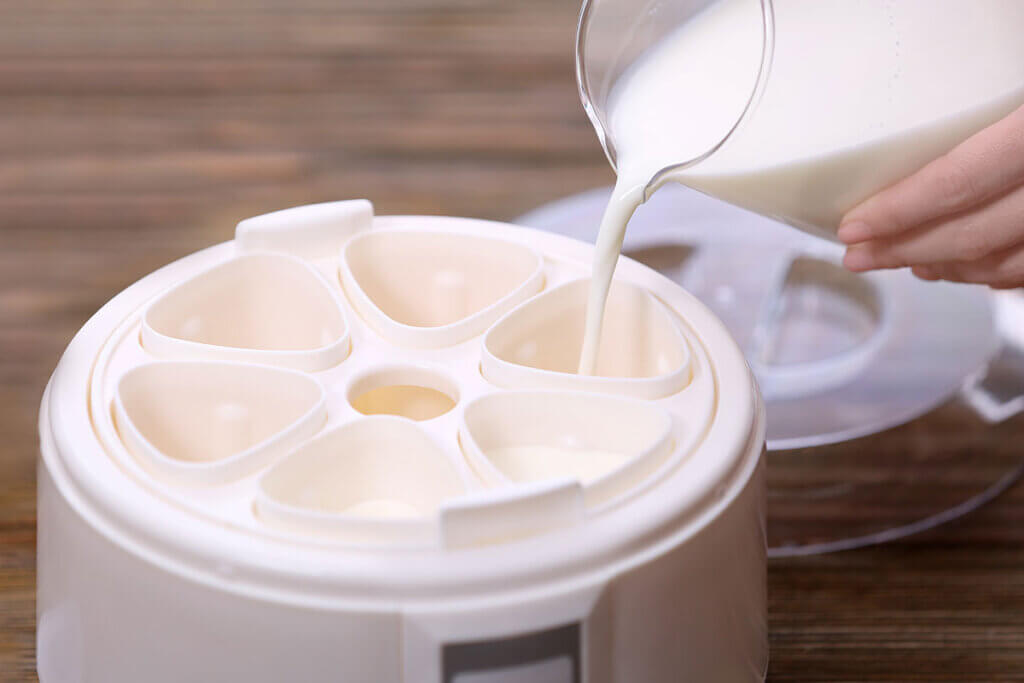
Extra features
Extra features make using a yoghurt maker even easier. A timer is a good example of this. It can be used to control the preparation time to create different textures of yoghurt. Meanwhile, an automatic switch-off stops the yoghurt from over-maturing. Even with an automatic switch-off you should make sure to remove and cool your yoghurt as soon as it is ready. People who think they will get their money’s worth from these extra features should opt for an electric yoghurt maker.
Controlling consistency & taste
Should the yoghurt be mild or a little sour? What consistency do you prefer—runny or hard? The length of the maturation also affects the taste. Making yoghurt at home is all about finding what suits your preferences the best.
Dimensions & weight
Yoghurt makers are either round or square. The dimensions vary greatly depending on the amount of yoghurt they are capable of making and the number of containers they hold. Most of the time, however, the dimensions are linked to the capacity. Naturally, models which are only capable of making small amounts are smaller. A normal electric model containing eight portion containers with a total capacity of 1.5 litres would be around 35x20x15 cm in size. The weight of the product varies depending on the size of the product in question, ranging from around 600g to over 3kg.
Tips for usage, storage, and cleaning
Although using a yoghurt maker is extremely easy, you should make sure to pay attention to a few important things. Which yoghurt culture and type of milk are best to use? Do all yoghurt makers have to be cleaned by hand? What is going to help the yoghurt to stay fresh for as long as possible?
Yoghurt culture
Yoghurt enzymes are another name for yoghurt culture and are the best thing to use to get a yoghurt started. An alternative is Greek natural yoghurt, which contains about as much fat as it does cultures. It is important that any Greek yoghurt you use does not contain additives and that it has not undergone any heating procedure. This is because heated milk loses its lactic acid bacteria. Yoghurt you have made yourself can also be used as a start culture. How often you do this depends on the amounts you wish to make.
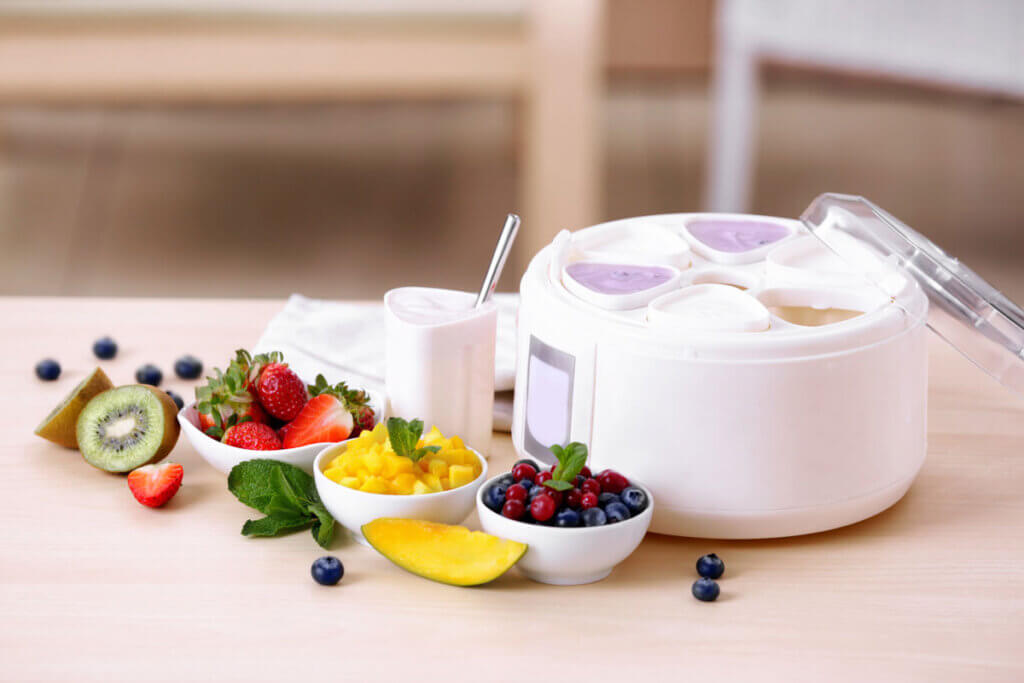
Choice of milk
Yoghurt makers are capable of working with both full-fat and low-fat milk, making them perfect for those watching their caloric intake. It does not even matter whether the milk is fresh or long-life. It is suggested, however, that the milk be cooked to 95°C before it is used in a yoghurt maker. This makes sure that all the germs have been killed off.
As a vegan option, yoghurt can also be made with alternatives like soy milk, almond milk, and oat milk. Lactose intolerance sufferers are, of course, recommended to make yoghurt with such alternatives. Types of milk with a higher fat content help to create a creamier result.
Using different bacteria
At one point in time, it was thought that D-lactate in fermented dairy products could be harmful. This has changed, but still today, doctors warn against overconsumption for under 12s. People who have undergone lower intestine surgery should also steer clear of D-lactate containing foods as they can be difficult to break down. L-lactate, meanwhile, is naturally produced by the body to draw oxygen.
Cleaning
Whether a yoghurt maker is dishwasher suitable varies from model to model. Electric yoghurt makers, as well as their electrical parts, should not be washed in a dishwasher, nor should they be carelessly washed by hand. Containers and portion pots are usually easy to wash in the dishwasher.
Storage
After the maturation process is finished, the yoghurt should be kept in the fridge. As a natural product without additives, it can usually be kept for about a week. As yoghurt is a milk product, smell can help you realise if it has turned. If unsure, you should carry out a taste test to see whether it tastes sour.
Image 1: © tashka2000 / stock.adobe.com | Image 2: © M.studio / stock.adobe.com | Image 3: © Africa Studio / stock.adobe.com | Image 4: © Africa Studio / stock.adobe.com

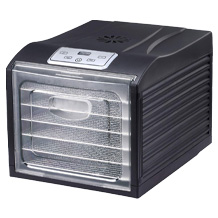
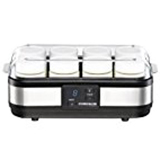
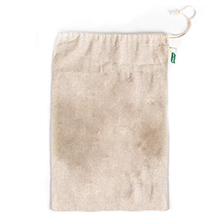
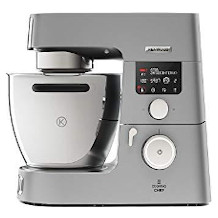
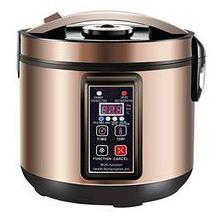
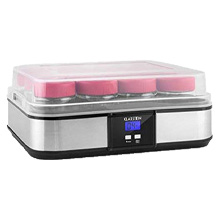
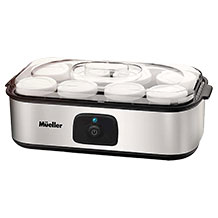
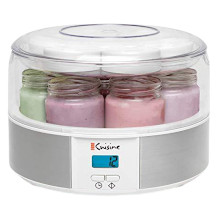

 363 reviews
363 reviews
